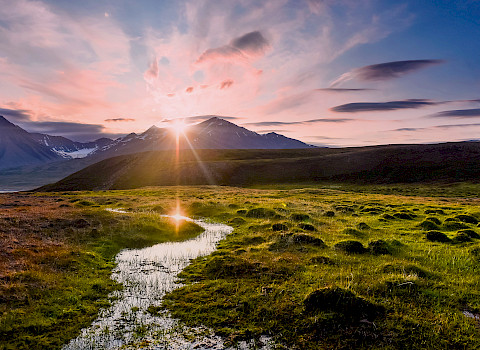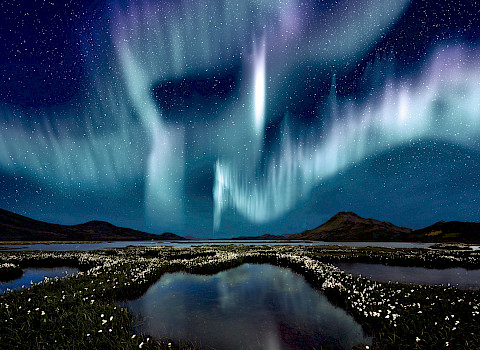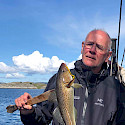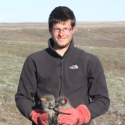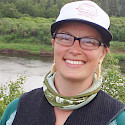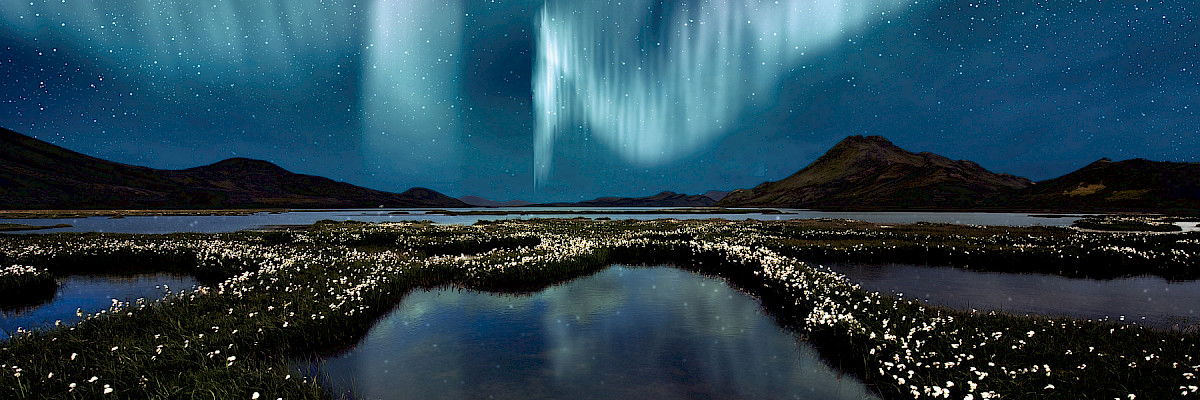
Resilience and Management of Arctic Wetlands (RAW)
Understanding the potential of wetlands to significantly contribute to climate adaptation and mitigation, and biodiversity conservation.
The Resilience and management of Arctic Wetlands (RAW) project strengthens engagement on the roles and functions of wetlands as a resource to support sustainable development and resilience in the Arctic.
It has delivered 13 key findings and 20 policy and management recommendations and is developing approaches to implement its recommendations.
Thirteen Key Findings were produced capturing the outcomes of this project and reflecting the issues and challenges that need to be addressed to ensure resilience and sustainable management of Arctic Wetlands:
- Arctic wetlands provide important ecosystem services to Arctic and global communities, including cooling the global climate. They provide clean water and buffer floods and droughts, support fisheries and hunting, support biodiversity, and act as long-term sinks for atmospheric carbon. Wetlands are an integral part of many Indigenous Peoples’ lives; they provide and sustain food security, including grazing for traditional reindeer herding. Recognition of wetlands’ importance, including in the Arctic, is growing as their role in sustaining a wide range of ecosystem services becomes better understood.
- The substantial ecosystem services provided by Arctic wetlands should be recognized at the international level. Presently, there is limited coordination on how ecosystem services from Arctic wetland management are reported to international frameworks or conventions on climate change mitigation and biodiversity. Common guidelines on how ecosystem services gained from wetland conservation and restoration actions are reported internationally could increase their global recognition.
- Anthropogenic climate change is a serious threat to Arctic wetland ecosystems and exacerbates many other threats. Widespread climate change impacts in Arctic wetlands are ongoing and projected to increase in this century and reducing greenhouse gas emissions is necessary to limit these impacts. Climate-driven permafrost thaw and increased drought conditions impacting wetland ecosystems will cause greater fire occurrences and shifts in hydrological flows, affecting wetland ecosystem services and biodiversity. Sea level change and declines in sea ice are driving increases in coastal erosion that threatens many coastal wetlands. Thawing permafrost is projected to transform peatlands from a net sink of greenhouse gases to a net source lasting for several centuries.
- Although the majority of Arctic wetlands remain relatively intact, changes are already occurring across the Arctic and wetland resilience is needed to buffer further damage. Wetlands are vulnerable to substantial indirect damage e.g. through global warming, changes to precipitation patterns, altered hydrological flows, and environmental pollutants. Such damage also constitutes a broader threat to migratory animal populations. These diverse threats to wetland ecosystems emphasize the need for landscape scale management with a focus on conservation, protection and maintained resilience.
- In some regions, Arctic wetlands are already degraded by human land use and an ever-growing human footprint poses threats to wetland functioning. This damage occurs in both Arctic and Boreal zones and arises from a number of threats such as expansion of forestry, agriculture, hydropower, extraction of peat, fossil fuels or minerals, threats to coastal wetlands from increased Arctic shipping and construction of new infrastructure. Wetlands are also vulnerable to human disturbances to permafrost or adjacent upland habitats and changes to the water balance or hydrological connectivity that can transform wetland function. Drained wetlands release carbon to the atmosphere instead of storing it, and the negative effect lasts for decades to centuries. Other losses of function include loss of biodiversity, changes to habitats and reduced capacity to buffer floods or droughts.
- Indigenous Peoples’ knowledge and stewardship is important for successful management of Arctic wetlands. Participation and leadership by Indigenous Peoples is needed for decision-making and management of Arctic wetlands. Indigenous Peoples’ hold extensive and unique knowledge regarding the wetlands in their homelands. In many places, long-term indigenous stewardship has partly shaped present-day wetland biodiversity and functioning, maintaining traditional land-use practices that acts to preserve wetland resilience.
- The extensive scientific, Indigenous, institutional, and local knowledge on Arctic wetlands could inform broad and rapid actions to protect, conserve and restore wetlands if supported by policy. Noting the stewardship and wealth of knowledge of Arctic communities, and existing science, the key obstacles to scaling-up research or case studies are not due to lack of knowledge. Multiple case studies and research projects have demonstrated that protection, conservation or restoration of degraded Arctic wetlands offers substantial benefits for water-centric ecosystem services, biodiversity, and climate change mitigation. In addition to Indigenous, institutional, and local knowledge of wetlands, there is a considerable and broad scientific knowledge base on wetlands protection, conservation, restoration, and management which dates back many decades. All of this knowledge is crucial for adaptive and holistic management of wetlands.
- Improved public and policymaker understanding of wetland functions and vulnerability would likely foster greater interest in protecting and conserving Arctic wetlands and strengthen involvement in promoting sustainable wetland use. Yet, the ways in which public opinion and networks of interested commercial and civil society organizations influence the development and implementation of wetlands conservation, restoration and stewardship in the Arctic are poorly understood. Systematic knowledge of the array of interest organizations’ relationships to wetlands and how they engage on questions of balancing conservation and use would support the development of more coherent and effective policies.
- Policy inconsistencies and practical difficulties with implementation are obstacles in wetland management or restoration efforts. Goal conflicts or gaps in policies undermine successful implementation of good wetland management or restoration practices. Key challenges include: (i) inconsistencies or conflicts between different national-level policies or between national and sub-national policies, (ii) the organization of responsibility between multiple agencies with differing mandates, and (iii) challenges in ensuring effective coordination and communication between agencies and the public.
- Substantial and rapid benefits for ecosystem services such as climate stability, biodiversity conservation and hydrological systems could be gained through restoration of drained or degraded Arctic peatlands. Degraded wetlands exist in all Arctic states and are particularly common in Boreal regions where extensive drainage for forestry, mining or peat extraction has occurred, or in Tundra where vulnerable permafrost wetlands have been degraded by unsustainable human land-use. Re-wetting of artificially drained or restoration of damaged wetlands could lead to substantial increases in natural carbon sink capacities. To achieve long-term success, restoration efforts should be planned together with conservation of undamaged systems as part of a landscape scale approach to sustainable management.
- Coordinated transboundary management of wetlands is needed, but different national systems for wetland classification challenge such efforts. There are crucial differences between wetland classification systems. A uniform system for comparing and harmonizing existing Arctic wetland classifications would help to better plan wetland actions that span borders, traditions, and cultures. New developments should consider the value and legacy associated with existing national classification systems and Indigenous Knowledge and Local Knowledge of wetland areas. Development of new classification systems, maps and databases should ensure that legacy data remains useful, allow for conversion between systems and link to Indigenous Knowledge and use of wetlands.
- There is a need for new pan-Arctic wetland maps based on a uniform approach, thus ensuring comparable accuracy and data quality across the full Arctic domain. Such mapping efforts should ideally train and validate algorithms using existing national wetland inventories, relevant institutional data, inclusive of Indigenous Knowledge and/or input from Arctic communities. Maps are needed that show the spatial extent of discrete wetland complexes at high resolution and should separate mineral wetlands from organic wetlands (peatlands). On the shorter term, new maps of wetland extent will be bound to one specific classification system; it is not possible to address the diversity of existing systems. Over the longer term, boundaries between maps and monitoring dissolve. Spatial wetland data can be stored in spatial databases that allow flexible adaptation to different classification systems.
- There are numerous models for providing financial support to conservation or restoration of wetlands. Each of the Arctic states has developed ways to provide financial support for wetlands conservation and restoration efforts. While some of the particular strengths and benefits of each set of policies, program or model are country context-specific, many lessons are generalizable and therefore useful for expanding collaboration across the Arctic states. A systematic review of these national-level restoration financing initiatives would provide valuable insights into development of effective tools.
ARCTIC WETLANDS FAQ
WHAT CHALLENGES DO WETLANDS IN THE ARCTIC FACE?
Wetlands areas have often been considered wastelands – areas thought largely useless, even hazardous, due to their waterlogged or water-covered condition through significant periods of the year. This widespread misunderstanding led to wetlands being drained, landfilled, even paved over, depriving both people and nature of wetlands’ many critically important ecosystem functions and benefits to people.
HOW CAN THE MANAGEMENT OF WETLANDS CONTRIBUTE TO HEALTHY ARCTIC ECOSYSTEMS?
Effective management of Arctic wetlands, including restoration and conservation, holds enormous potential to contribute significantly to climate adaptation and mitigation, protect biodiversity and produce other benefits for both Arctic and non-Arctic peoples and society. Moreover, Arctic wetlands are globally important, through their role as bird habitats and migration pathways, and linkages with climate regulation and other global ecosystem functions.
WHICH ECOSYSTEM FUNCTIONS DO WETLANDS PROVIDE?
Almost half the worlds wetlands are located in the Arctic where they make up as much as 60% of all Arctic ecosystems and include a complex mix of peatlands, shallow open waters, wet tundra’s and seashore areas. These areas provide a variety of crucial ecosystems functions and serve as forage and breeding habitats for sensitive wildlife, especially migratory birds and numerous fish species. They play a vital role in supporting the livelihoods and traditional lifestyles of indigenous people through their use for herding, harvesting food (berries) and extracting raw materials for a diverse range of products. Wetlands also store large amounts of carbon in frozen peat and soil. However, these crucial ecosystems are changing at a perilously fast pace, with Arctic wetlands becoming drier due to climate-change driven permafrost degradation and growing pressures from increased human presence. Also, climate change induced permafrost thaw is likely to increase greenhouse gas emissions from peatlands.
Phase 1: 2017-2019
In the first stage wetlands inventories across the Arctic were examined. Inventories provide important information for management and policy making. They serve as a baseline for future policy measures. According to the Ramsar Global Wetland Outlook 2018, there has been a steady increase in the number of countries producing national wetland inventories, reaching a reported 44% of Parties* with completed inventories and 29% in progress by 2018.
Phase 1 of this project reviewed scientific research on Arctic wetlands concerning key issues such as importance for biodiversity, hydrology, impacts of a warming climate and carbon storage, including a preliminary mapping on which ways these wetlands are essential to indigenous livelihoods. Incorporating local and indigenous knowledge is essential in the management of wetlands. Knowledge gaps and needs were also identified in this first stage.
- Project plan: Phase 1
- Sustainable Management and Resilience of Arctic Wetlands: Scoping Study
- Literature Review
- Wetlands in Sámi: Scoping Study
- Phase 1: Workshop Report
Phase 2: 2019-2020
The second and current stage of the project examined regulatory efforts and management approaches aimed at maintaining important wetlands functions through the use of illustrative case studies.
The insights gained through these case studies will deliver significantly deeper insights and actionable recommendations for policy and management that will be developed in the third phase of the project. The second phase will continue to compile wetland inventories and explore the knowledge of livelihoods uses of wetlands by Arctic Indigenous peoples in collaboration with the Sámi Council and other Permanent Participant organizations of the Arctic Council.
Phase 2 looked at 1) assembling wetland inventories across the Arctic and identifying ways of making them comparable; 2) Representative case studies to identify effective regulatory and management tools for restoring and protecting wetlands and effectively balancing conservation and use; and 3) a workshop to engage with relevant experts and to evaluate the compiled case studies and inventories, and to discuss further policy engagement.
Phase 3: 2020-2021
Phase 3 developed a a series of 13 Key Findings and 20 policy and management recommendations designed to act on these Key Findings.
Many of these findings and recommendations are highly relevant both within and outside the Arctic, and Arctic States have the opportunity to act as role models for sustainable use of wetlands.
INDIGENOUS PEOPLES AND ARCTIC WETLANDS
The intersection between Indigenous Peoples and wetlands is not well documented in the Arctic, nor are the relationships between Indigenous communities and protected area management authorities. The Arctic Wetlands and Indigenous Peoples Study (AWIPS) is the first assessment of Indigenous participation in protected area management across the Arctic. Drawing primarily from documentation of 35 protected areas in the eight Arctic States, this report provides a:
- Synthesis of the information documented on Indigenous wetland resource use and conservation;
- Framework for understanding the benefits of Indigenous participation in wetlands conservation; and a
- Snapshot of current practices of engaging Indigenous Peoples in wetlands management in the Arctic States.
This study identifies challenges and suggestions for developing and facilitating participatory processes that are inclusive of Indigenous perspectives, resource needs, and knowledge within broader conservation efforts. It provides a series of Key Findings, suggestions for future reserach and advice for management. These are designed to support decision-makers in understanding the diverse and valuable ecosystem services provided by Arctic wetlands and to identify specific actions they can implement to protect existing wetlands and restore those that have been degraded.
Related news
Arctic wetlands holds enormous potential for global climate adaptation, mitigation: new circumpolar report
A new circumpolar report outlines 20 recommendations to protect and sustain Arctic wetlands.CAFF activities at COP26
Please join the following COP26 side events where CAFF is engaged which focus on communicating the Key Findings and Recommendations from Wetlands project (RAW)Experts
-
Jan-Petter Huberth-Hansen
Resilience and Management of Arctic Wetlands representative; CBMP Terrestrial Steering GroupNorway -
Ward Hagemeijer
AMBI Steering Group representative, Resilience and Management of Arctic Wetlands representative
 Arctic Council Working Group
Arctic Council Working Group 